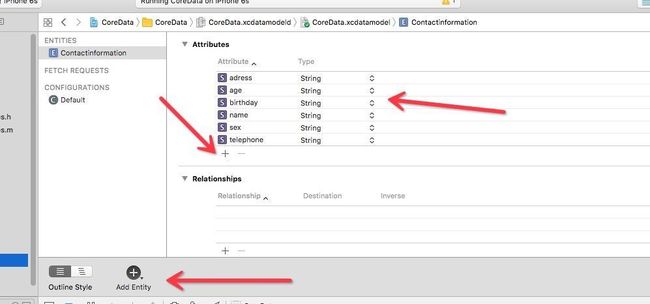1.Core Data 含义:
Core Data(数据库)是数据持久化存储的最适合的方式,通过一系列特性避免使用SQL的一些麻烦,还能合理管理内存。
Core Data是iOS5之后才出现的一个框架。
它提供了对象-关系映射(ORM)的功能,即能够将OC对象转化成数据,保存在SQLite数据库文件中,也能够将保存在数据库中的数据还原成OC对象。
在此数据操作期间,我们不需要编写任何SQL语句,这个有点类似于著名的Hibernate持久化框架,不过功能肯定是没有Hibernate强大的。
2.Core Data 优点:
利用Core Data框架,我们就可以轻松地将数据库里面的2条记录转换成2个OC对象,也可以轻松地将2个OC对象保存到数据库中,变成2条表记录,而且不用写一条SQL语句。
在Core Data,需要进行映射的对象称为实体(entity),而且需要使用Core Data的模型文件来描述app中的所有实体和实体属性。
3.Core Data 支持的存储类型:
SQLite、内存、二进制、XML、自定义数据类型
4.Core Data 的使用:
例子:对用户输入的信息放入数据库,可对数据进行保存、删除、查看
||
||
方法saveContext表示:保存数据到数据库。
方法applicationDocumentsDirectory表示:应用程序沙盒下的Documents目录路径。
||
||
简单了解NSManagedObject:
1.通过Core Data从数据库取出的对象,默认情况下都是NSManagedObject对象。
2.NSManagedObject的工作模式有点类似于NSDictionary对象,通过键-值对来存取所有的实体属性:
1> setValue:forKey:存储属性值(属性名为key)
2> valueForKey:获取属性值(属性名为key)
||
||
||
||
Contactinformation.h文件Demo:
#import
#import //导入分类
NS_ASSUME_NONNULL_BEGIN
@interface Contactinformation : NSManagedObject
//返回实体名(类名)
+ (NSString *)entityName;
@end
NS_ASSUME_NONNULL_END
#import "Contactinformation+CoreDataProperties.h"
||
Contactinformation.m文件Demo:
#import "Contactinformation.h"
@implementation Contactinformation
+ (NSString *)entityName{
return @"Contactinformation";
}
//重写description
- (NSString *)description{
return [NSString stringWithFormat:@"",self.name,self.age,self.sex,self.telephone,self.birthday,self.adress];
}
@end
||
####### 封装保存、插入、删除数据库的数据方法
CoreDataManager.h文件的Demo
//封装保存、插入、删除数据库数据
#import
@interface CoreDataManager : NSObject
//插入
+ (BOOL)insertObjectWithParameter:(NSDictionary *)parameters entityName:(NSString *)entityName;
//查询
+ (NSArray *)readentityName:(NSString *)entityName predicate:(NSString *)predicateString;
//删除
+ (BOOL)removeWithEntityName:(NSString *)entityName predicate:(NSString *)predicateString;
@end
CoreDataManager.m文件的Demo
#import "CoreDataManager.h"
#import "AppDelegate.h"
@implementation CoreDataManager
//委托对象上下文方法
+ (NSManagedObjectContext *)managedObjectContext{
//获取程序唯一的委托对象上下文,用于存储、查询、删除
return [(AppDelegate *)[UIApplication sharedApplication].delegate managedObjectContext];
}
//插入
+ (BOOL)insertObjectWithParameter:(NSDictionary *)parameters entityName:(NSString *)entityName{
if (entityName.length == 0) { //异常情况判断
return nil;
}
//获取数据(已存在parameters对象中)
//用实体名实例化模型对象
NSManagedObject *contect = [NSEntityDescription insertNewObjectForEntityForName:entityName inManagedObjectContext:[self managedObjectContext]]; //用NSManagedObject父类接收
//把数据存入实体对象
for (NSString *key in parameters) {
//KVC (建立的值一样才能用KVC)
[contect setValue:parameters[key] forKey:key];
}
//保存同步文件
BOOL success = [[self managedObjectContext] save:nil];
NSLog(@"是否保存成功:%d",success);
return success;
}
//查询
+ (NSArray *)readentityName:(NSString *)entityName predicate:(NSString *)predicateString{
if (entityName.length == 0) { //异常情况判断
return nil;
}
//1.实例化查询请求类
NSFetchRequest *fetchRequest = [NSFetchRequest fetchRequestWithEntityName:entityName];
//2.配置查询条件(可选操作)
if (predicateString.length > 0) {
fetchRequest.predicate = [NSPredicate predicateWithFormat:predicateString]; //年龄等于6才能保存
}
//3.执行查询
NSArray *results = [[self managedObjectContext] executeFetchRequest:fetchRequest error:nil];
NSLog(@"results = %@",results);
return results;
}
//删除
+ (BOOL)removeWithEntityName:(NSString *)entityName predicate:(NSString *)predicateString{
if (entityName.length == 0) { //异常情况判断
return nil;
}
NSArray *results = [self readentityName:entityName predicate:predicateString]; //调用查询数据库方法 //1.2.3.步骤在查询数据库方法中
//4.数据对象的删除 (从数据库中删除)
for (id object in results) { //所有数据
[[self managedObjectContext] deleteObject:object];
}
//5.保存同步数据
BOOL success = [[self managedObjectContext] save:nil];
NSLog(@"是否删除成功:%d",success);
return success;
}
@end
||
下面ViewController.m文件是关于iOS界面与如何使用数据库的Demo
#import "ViewController.h"
#import "Contactinformation.h"
#import "AppDelegate.h"
#import "CoreDataManager.h"
static const NSInteger TEXTFIELD_BASE_TAG = 20;
@interface ViewController ()
@property (nonatomic, strong) NSArray *keys;
@end
@implementation ViewController{
//声明变量
//委托对象上下文
NSManagedObjectContext *_context;
}
//初始化
- (instancetype)initWithCoder:(NSCoder *)aDecoder{
self = [super initWithCoder:aDecoder];
if (self) {
//获取程序唯一的委托对象上下文,用于存储、查询、删除
_context = [(AppDelegate *)[UIApplication sharedApplication].delegate managedObjectContext]; //有一个强转否则不认识 //获取程序单例(唯一)
}
return self;
}
- (void)viewDidLoad {
[super viewDidLoad];
_keys = @[@"adress",@"name",@"age",@"sex",@"telephone",@"birthday"];
for (int i = 0; i < 6; i ++) {
UILabel *label1 = [[UILabel alloc] initWithFrame:CGRectMake(30, (20 + 30 * i) * 2, 100, 30)];
label1.text = [_keys[i] stringByAppendingString:@":"];
label1.textAlignment = NSTextAlignmentRight;
[self.view addSubview:label1];
UITextField *text = [[UITextField alloc] initWithFrame:CGRectMake(140, (20 + 30 * i) * 2, 200, 30)];
text.backgroundColor = [UIColor whiteColor];
text.layer.borderColor = [UIColor grayColor].CGColor;
text.layer.borderWidth = 1;
text.tag = TEXTFIELD_BASE_TAG + i;
text.layer.cornerRadius = 8;
[self.view addSubview:text];
}
NSArray *array1 = @[@"save",@"read",@"clear"];
for (int i = 0; i < 3; i ++) {
UIButton *button = [UIButton buttonWithType:UIButtonTypeSystem];
button.frame = CGRectMake((30 * i + 20) * 3, 400, 50, 30);
button.backgroundColor = [UIColor clearColor];
[button setTitle:array1[i] forState:UIControlStateNormal];
button.titleLabel.font = [UIFont systemFontOfSize:18];
button.tag = 100 + i;
[button addTarget:self action:@selector(button:) forControlEvents:UIControlEventTouchUpInside];
[self.view addSubview:button];
}
}
- (void)button:(UIButton *)sender{
if (sender.tag == 100) {
[self insertContext];
}else if (sender.tag == 101){
[self readContext];
}else{
[self clearContext];
}
}
//插入
- (void)insertContext{
//采用封装
[CoreDataManager insertObjectWithParameter:[self contactInformation] entityName:[Contactinformation entityName]];
}
//查询
- (void)readContext{
//采用封装
[CoreDataManager readentityName:[Contactinformation entityName] predicate:nil];
}
//删除
- (void)clearContext{
//采用封装
[CoreDataManager removeWithEntityName:[Contactinformation entityName] predicate:nil];
}
//文本框内容获取方法
- (NSDictionary *)contactInformation{
NSMutableDictionary *dic = [NSMutableDictionary dictionary];
for (NSInteger i = 0; i < _keys.count; i ++) {
UITextField *field = (UITextField *)[self.view viewWithTag:TEXTFIELD_BASE_TAG + i];
if (field.text.length > 0) {
[dic setObject:field.text forKey:_keys[i]];
}
}
return dic;
}
@end
例子演示结果:
Core Data中的核心对象









